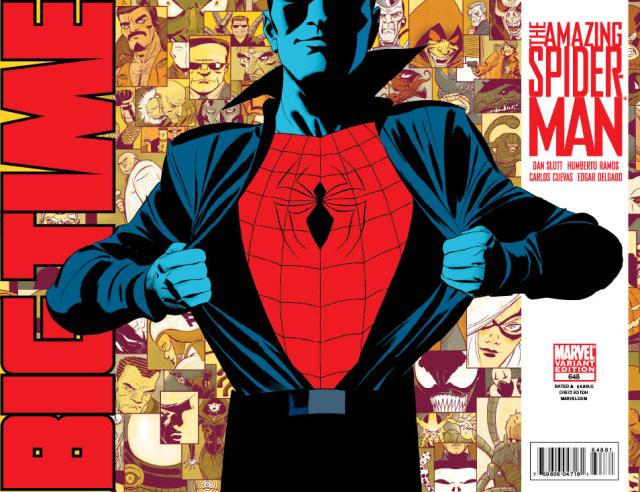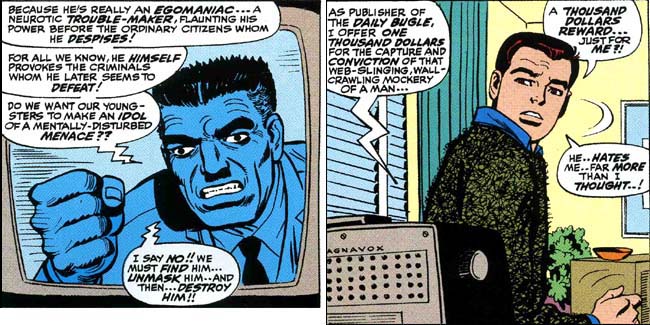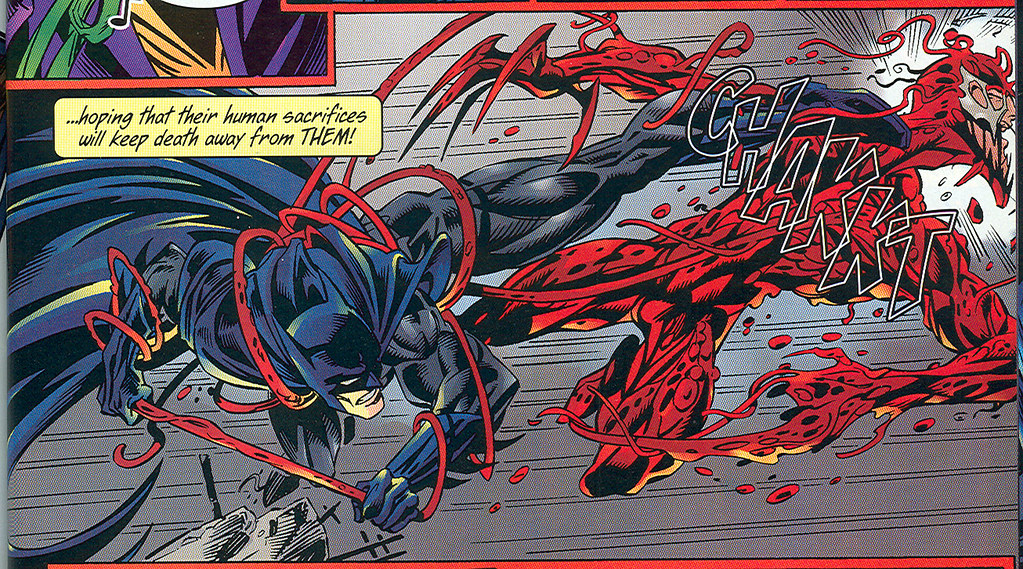It’s safe to say that Spider-Man the Manga is one of the most insane versions of any mainstream superhero ever. It’s kinda like the Adam West Batman TV show, although Marvel’s much less interested in doing anything with it for the last twenty years, even with manga more popular than ever and a legitimate superstar artist for the series in Ryoichi Ikegami (Crying Freeman, Heat, Mai the Psychic Girl.)
One odd thing about the series for a manga is that it changed writers. The first few volumes (published relatively intact in the United States) by writer Kōsei Ono introduced new versions of mainstays like Electro, Mysterio, the Lizard, J Jonah Jameson, Aunt May (Aunt Mei in this version) and the Kangaroo. The next writer Kazumasa Hirai took the series in a more adult direction, influenced by body horror and some of the more lurid crime films of the Japanese New Wave. Those issues were released out of order in the US, often with significant edits. I covered some of the stories that were never published in the US, and the remaining three stories were all very weird.

“The Mad Demon” kills off Yu Komori’s love interest. The entire run was published from January 1970 to September 1971, which means that this story came out before the death of Gwen Stacy. Rumi became a go-go girl (dancer at a nightclub.) She’s assaulted in a car which is then rammed by another lunatic. Yu sees her in the hospital, and realizes she’s been staying away from him because she thinks he’s too good for a fallen woman like her. And then she just succumbs to her injuries.
Yu joins the effort to find the mad demon, the term the media gives the villain, and is tutored by racer Taki Shogo. Due to his age, he can only use a motorbike. He develops a cynical attitude that the strong survive and the weak lose, as the mad demon starts to develop a following among people bothered by modern society and traffic jams. Yu doesn’t care about the motives since he lost someone he cares about.

It all ends in a showdown between Spider-Man on a motorcycle, and the mad demon. There’s an obvious twist with the mad demon that is pretty similar to other reveals in the series, although his motives have a tragic connection to the theme of people trapped in a life they don’t want.
In “The Golden Eyed Witch” weird stuff is happening at Yu Komori’s school, and it may be the fault of a Miss Miwa, a new teacher with golden eyes who seems to mesmerize the male students. An accident in which students are almost crushed to death in a staircase is particularly nasty. Komori’s spider-sense indicates something’s wrong. A principal who was suspicious of the new teacher is viciously killed by a dog, which seems the power to command other dogs to attack Komori. He follows the dog to his friend Akari’s house. He believes Miss Miwa is an actual witch, and then realizes he’s falling under her spell, with the potential that his powers as Spider-Man will cause great harm. She realizes something’s up with him, and tries to seduce him in the principal’s office.

Afraid of what may happen, Komori stops going to school, but other mesmerized people seem to follow him. Akira’s sister reveals that he tried to rape her, and Komori concludes that the witch has the power to turn people into animals, metaphorically and literally. He decides the only way to end things is to kill her. He heads to the school where some of the male students try to kill him, because there are gang wars between the second and third years who have taken over different sides of the school. However, Miwa has left. The school still goes to hell, with multiple students killed in fighting, cops taken hostage, and the public attacking the police in ensuing riots. Komori finds and confronts Miwa, who realizes that he’s Spider-Man. She claims that she never wanted to hurt anyone, and that the only evil she brings out in people is something that’s already within them. She asks Komori to save her from a mob, but he does nothing when a cop shoots her.

This storyline fits into earlier themes from the series. It’s a bit similar to the winter woman arc in Issues 22-24, as well as the final issue of people’s suffering leading to a physical manifestation of danger. It’s a bit like ghost stories, but the characters causing harm and messing with the fabric of reality are still alive. It’s almost too strange to review. I can understand why Marvel didn’t want to translate it. Looking at the summary you could get a sense of how violent the story gets, and I didn’t mention all of it. There are multiple references to sexual assault, and a mesmerized Yu is tempted when visiting a hospitalized classmate. When Spider-Man beats dogs into a bloody mess in a foreign comic, I get the immediate sense that a lot of people at Marvel don’t want to touch this with a ten foot pole.

And it’s really long. At over 200 pages, it would take up quite a few issues. The story doesn’t feature a name villain, or a particularly commercial concept. Even if they could edit it to something that isn’t going to cause headlines on Fox News, releasing a bowdlerized version would only bring attention to the original, which is available online through unofficial sources. And that’s a headache Marvel would prefer to avoid. So for them, it’s not worth releasing a very niche product.

“The Woman and the Tiger” is a shorter piece from the final volume. A man who seems to be attacked by an invisible tiger dies in Komori’s arms. A reporter asks Komori for information, revealing that the victim was a member of a band that had recently broken up. Several of the others died under strange circumstances, and the one survivor is getting drunk out of his mind in bars, claiming he’s being followed by a tiger. Komori and the reporter confront him, and he claims that the gang is cursed after they were ordered to rape a singer named Miki and gave her an STD. The musician is grabbed by yakuza, and the reporter suggests that organized crime was involved in destroying Miki’s career, because she wasn’t willing to go along with everything they wanted. The reporter is scared off, but Komori decides to expose the crimes of the yakuza affiliated talent agency.
Komori finds Miki in a bar, where she’s still hoping for a big break. She sets him up for an ambush by the yakuza, although he’s able to handle them with the help of the tiger. He realizes that she’s causing it to manifest when she’s asleep and dreaming about the terrible things that have happened to her. Komori visits the agency, and tries to convince the president who was terrible to Miki to apologize to her, lest she be a victim of the tiger. She refuses. He leaves, saying he tried to help her. The yakuza realize what’s going on, and try to kill Miki. One of their agents stabs her. Komori decides not to save her, while the tiger kills all of her enemies. Komori realizes he has the same anger inside of him.

Reading it, I understand why Marvel didn’t want to translate this one either, and why they didn’t republish earlier stories when manga became more popular in the 2000s. In one sense, releasing some volumes at that point was a no-brainer. Marvel had already done the translations. They owned the rights. The stories they had done were more commercial with American audiences, with traditional supervillains illustrated by a top manga talent. There’s no obligation to translate other stories. But anything Marvel did on the question would lead to publicity for stories that are very off-brand and quite difficult to explain to sensitive American audiences or comic book commentators.
This is closer to hyperviolent manga like Lone Wolf & Cub or Crying Freeman, than it is to anything we traditionally associate with Spider-Man. It has artistic merit, with a cynical view of the human condition, but one that works for a story about a young guy wrestling with the potential for great good and great harm. It’s not a trait of our Spider-Man to allow a woman to die because she causes great harm against bad people, and everything else is a very different direction for Spider-Man or for any Marvel hero than we’re used to. There is some stuff here that Image or Dark Horse would likely consider too messed up to publish, let alone Marvel.

This was one of the first serious alternate version of the Spider-Man comics. When it started Stan Lee was still writing Amazing Spider-Man, so the writers of the manga are some of the first to take these concepts in a different direction. It’s a more selfish and indecisive take, although it’s understandable that an angry young man might feel this way. It’s also understandable that this likely won’t be published in the US until all the copyrights expire.









